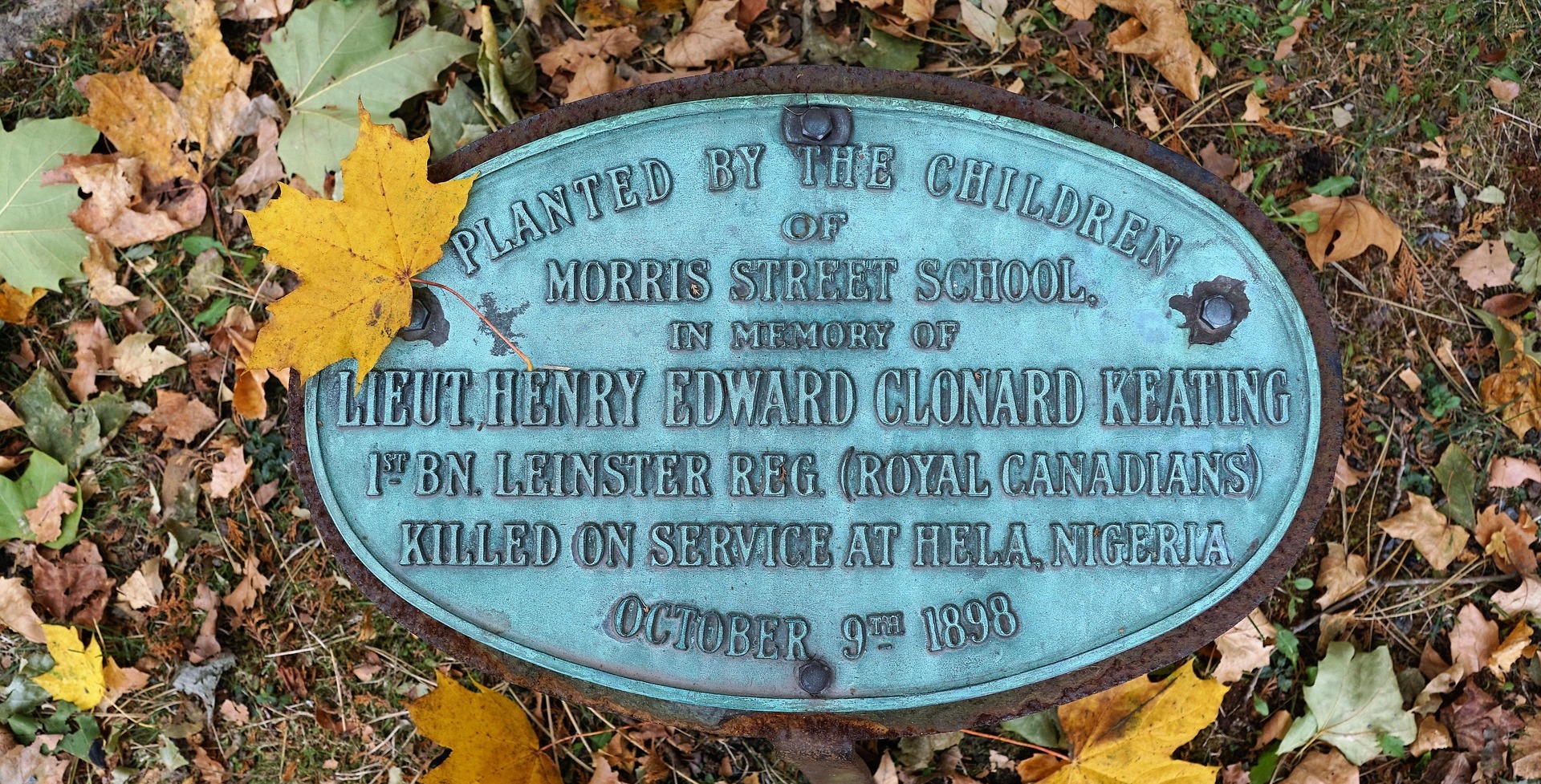Some good might come in Canada from neo-fascists marching in Charlottesville, Virginia.
Taking advantage of media interest in protests over monuments to historical figures with racist views activists in Halifax are pushing to remove commemorations to two individuals who helped conquer Africa. And there’s no lack of other such memorials to target across the Great White North.
In 1898 Henry Edward Clonard Keating led a small force that killed the chief of Hela and abducted several individuals from the village to operate canoes the soldiers had stolen from them. In response, others from the village in what is now southern Nigeria attacked and killed most of Keating’s force. A British force then razed Hela and killed about 100 locals. There’s a plaque commemorating Keating in Halifax’s Public Gardens.
Dalhousie Professor Afua Cooper is also pushing to rename Stairs Street in Halifax. William Grant Stairs played an important part in two expeditions that helped Belgian King Leopold II expand his barbarous reign in the Congo. Also commemorated with an Island in Parry Sound, Ontario, and two plaques in Kingston, the Haligonian was one of 10 white officers in the first-ever European expedition to cross the interior of the continent and subsequently Stairs led a 2,000 person force that added 150,000 square kilometres to Leopold’s colony.
Read from a humanistic or internationalist perspective, the Royal Military College of Canada (RMC) graduate’s diary of his time in Africa is incredibly damning. Or, as Parliamentary Poet Laureate George Elliott Clarke put it, “Stairs’ account of his atrocities establishes that even Canadians, blinded by racism, can become swashbuckling mass murderers.”
Stairs and Keating are two of many Canadians who helped colonize the continent and continue to be commemorated (a number of British figures who fought in Africa are also honoured across the country).
In Kingston two plaques honour RMC trained Huntley Brodie Mackay. Commanding Royal Engineer in West Africa, Mackay was part of a British expedition to destroy the Yonnie stronghold of Robari in what is now southeast Sierra Leone. In the fighting the soldiers employed the first ever recoil-operated Maxim machine gun, reported MacMillan’s magazine. “Maxim, which here administered rather than received its baptism of fire, was turned on them, and they dropped off the roofs by dozens…When the leading troops entered the gates…there was not a living Yonnie left in the town, although there was no lack of their dead.”
Replacing Mackay as West Africa’s Commanding Royal Engineer in 1889, Saint John-born William Henry Robinson also has a plaque in his honour at the RMC. In 1892 the 29-year-old led a small force to destroy a rebellion not far from the former Yonnie stronghold. In “Canadian Soldiers in West African Conflicts 1885-1905” Andrew Godefroy explains: “When Robinson and his party of Sierra Leone Frontier Police attacked his stockade on 14 March, however, [rebel leader] Karimu was ready to receive them and repulsed their initial assault. The momentum lost, Captain Robinson tried to rally the attack by personally setting explosive charges at the gates, hoping to blow them open and allow for his men to rush through.” Robinson was shot in the battle and ultimately became the first RMC graduate to give his life fighting for British colonialism.
A mountain in Banff National Park, as well as a plaque and building at RMC, are named in honour of Sir Edouard Percy Girouard. The Montréaler built two train lines that played a central part in the brutal British conquest of Sudan and was Director of Imperial Military Railways during the 1899 – 1902 Boer War (numerous monuments commemorate Canadians who fought in that conflict to strengthen British colonial authority in Africa, which ultimately led to racial apartheid). In 1906 the RMC graduate became High Commissioner of Northern Nigeria, ruling over 10 to 20 million people. Girouard employed forced labour to construct a 550-km railway and justified strengthening precolonial authority by saying colonial authorities didn’t want, “to deal with a rabble, with thousands of persons in a savage or semi-savage state, all acting on their own impulses.”
After Northern Nigeria, Girouard became governor of British East Africa from 1909 to 1912. Girouard sought to turn today’s Kenya into a “white man’s country.” He abrogated the sole treaty the East African protectorate had ever signed with an African tribe. Weakened by disease and confronting an ascendant Britain, in 1904 the Masai agreed to give up as much as two thirds of their land. In exchange, the cattle rearing, semi-nomadic people were assured the fertile Laikipia Plateau for “so long as the Masai as a race shall exist.”
By Girouard and Britain’s odd calculation, the agreement expired fewer than seven years later. About 10,000 Masai, with 200,000 cattle and 2 million sheep, were forced to march 150 km southward to a semiarid area near German East Africa. An unknown number of Masai and their livestock died on this “trail of tears.”
Campaigns to remove monuments or rename places named after Canadians who participated in the “scramble for Africa” can help educate the public about Canada’s history on the continent and European colonialism more generally.
In order to more forward to a better future Canadians must reconcile with the wrongs committed in our past, both on this continent and around the world.
Like this article? rabble is reader-supported journalism.




